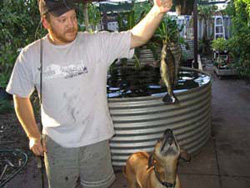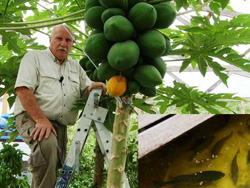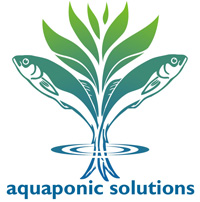Aquaponics
Aquaponics is simply the combination of aquaculture
(growing fish in water) and hydroponics (growing plants
in water). Just add water…
A simple idea, borrowed from nature, but with extraordinary results
for modern gardeners:
- 90% less water used than for a conventional garden.
- 5 times the plant growth rate of a conventional garden.
- Fish can be grown for the plate or kept as pets.
How Aquaponics works
It is actually a very simple, and very natural idea - plants and fish
growing symbiotically in a closed system.
- Fish live in the fishpond/tank.
- The water from the pond, enriched with fish waste, is used to
feed plants in separate grow beds.
- The plants, along with healthy, naturally occurring bacteria,
clean the water.
- The water is delivered back to the fish, being oxygenated along
the way.
Organic vegetables can be grown highly efficiently in the nutrient
rich pond water.
Fish, yabbies, mussels etc can be grown in the closed system
providing a constantly renewable food source - and they are
interesting to watch as well.
No chemicals, no fuss, just fresh fish, herbs and vegetables.
FAQ
Q: How do aquaponic systems work?
A: There are many types of aquaponic systems, but here are the basics (media-based)
-
Fish are grown in tanks or ponds, nutrient rich water from the pond is pumped into grow beds,
- The grow beds are filled with media (gravel or expanded clay) which allow the growth of beneficial bacteria
- Plants grown in the media use the good bacteria in the water which has been converted to nitrate by the bacteria
-
Water, now cleaned of nutrients, is drained back into the pond and as grow beds empty, the roots are oxygenated.
Q: What plants can be grown in an aquaponic system?
A: Nearly every plant and herb grown in soil, including fruit trees, have been successfully grown in aquaponic systems across the world, from everyday herbs and veges to cactus and aloe vera, citrus trees, passion fruit and even mushrooms
- pond plants and edible water plants can also be grown in your pond/tank. Note however these will
take nutrients away from the grow beds
- most importantly grow what you like to eat. Q: What type of fish?
A: Silver perch, jade perch, barrumundi and trout are the most common edible fish in Australian aquaponics systems,
-
gold fish and koi are popular ornamentals, we recommend a few goldfish (feeder fish) until your system fully cycles
-
Yabbies, mussels, shrimp are a great addition.
-
you will need to consider your climate when choosing fish and keep a low stock until your system has to properly cycled and built up enough beneficial bacteria , and you are confident in your understanding of aquaponics.
-
You don't have to eat your fish, just make the most of the poo for growing herbs and vegetables. Q: What fish food?
A: Aquaculture pellets are the most popular fish food,
-
worms, black soldier fly larvae, duck weed and algae are more sustainable options but harder grow in large enough quantities
Q: How long until an aquaponic system is productive?
A: Systems take a good month to cycle and for the good bacteria to build up
- Seasol and worm juice can be added to provide the plants with more nutrients
- it can take a couple of months or so for the plants to thrive
- do not add too many fish until the system has cycled properly
- once good bacteria has matured the system will remain highly productive for years to come
Q: Ponds and aquaponics?
A: Ponds can be easily retrofitted to an aquaponic system with the addition of a grow beds.
- ponds must be lined, rather than earthen, as soil will affect the biology
- you don't need silver perch and other edible fish, as ornamental fish are just as suitable in providing nutrients to the grow beds, grow beds will also keep the pond water clear
- ponds are often subject to sunlight, so make sure there are places for the fish to hide,
- remember ponds plants will take some of the nutrients from the grow beds
and regularly check pump flow rate to ensure leaves don't clog your pump.
- don't panic if your pond appears green after a lot of sunlight, especially if your grow bed bacteria has not matured Q: Is aquaponics complicated?
A: Basic systems are easy to use and lower stocking rates are quite safe, with limited instructions
- as you read and become more experienced, and your good bacteria matures you can start increasing fish stocks
- when you become addicted you can incorporate more complicated systems.
Want to know more about aquaponics? buy a book... or refer to these great Australian websites.
 |
Joel Malcom - "Backyard
Aquaponics"
www.backyardaquaponics.com
Joel was one of the earliest practitioners of aquaponics in Australia, promoting discussion around the world on creating DIY systems.
Joel also sells books, DVD, aquaponic kits and components
Based in Western Australia |
 |
Murray Hallam - "Practical Aquaponics"
www.aquaponics.net.au
One of Australia's leading experts and promoters of aquaponics. Murray's books DVDs and presentations have inspired the world
Murray sells
a wide range of books, DVDs, components and kit systems
Based in Queensland |
 |
Shannida and Matt Herbert - "Aquaponics in Australia"
www.aquaponics.com.au
The #1 best selling book on aquaponics and includes instructions on how to build your own system,
technical aspects of aquaponics are explained in layman's terms.
great overview of aquaponics on there website
Based in New South Wales
|
 |
Aquaponic Solutions - Dr Wilson Lennard
The leading expert on aquaponics in Australia, he has a PhD in Applied Biology (focussing on aquaponics), and has developed "SYMBIOPONICS™" which scientifically quantifies aquaponics systems.
Dr Wilson specialises in commercial aquaponic systems.
I highly recommend his Backyard System Design Tool, to optimise your backyard system (let us know your results)
www.aquaponic.com.au
Based in Victoria |
| |
|
Would you like to know more about aquaponics or our custom designed systems?
contact info@ecolicious.com.au
©2010-11 copyright ecolicious
|





